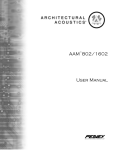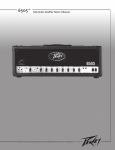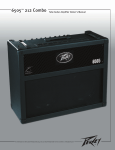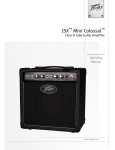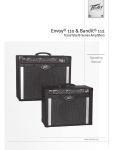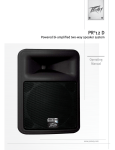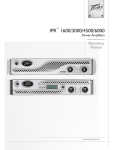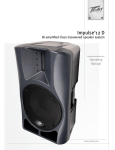Download Peavey 2443/3243 Music Mixer User Manual
Transcript
User Manual AAM™ 2443/3243 Analog Audio Mixer Intended to alert the user to the presence of uninsulated “dangerous voltage” within the product’s enclosure that may be of sufficient magnitude to constitute a risk of electric shock to persons. Intended to alert the user of the presence of important operating and maintenance (servicing) instructions in the literature accompanying the product. CAUTION: Risk of electrical shock — DO NOT OPEN! CAUTION: To reduce the risk of electric shock, do not remove cover. No user serviceable parts inside. Refer servicing to qualified service personnel. WARNING: To prevent electrical shock or fire hazard, this apparatus should not be exposed to rain or moisture‚ and objects filled with liquids‚ such as vases‚ should not be placed on this apparatus. Before using this apparatus‚ read the operating guide for further warnings. Este símbolo tiene el propósito, de alertar al usuario de la presencia de “(voltaje) peligroso” sin aislamiento dentro de la caja del producto y que puede tener una magnitud suficiente como para constituir riesgo de descarga eléctrica. Este símbolo tiene el propósito de alertar al usario de la presencia de instruccones importantes sobre la operación y mantenimiento en la información que viene con el producto. PRECAUCION: Riesgo de descarga eléctrica ¡NO ABRIR! PRECAUCION: Para disminuír el riesgo de descarga eléctrica, no abra la cubierta. No hay piezas útiles dentro. Deje todo mantenimiento en manos del personal técnico cualificado. ADVERTENCIA: Para prevenir choque electrico o riesgo de incednios, este aparato no se debe exponer a la Iluvia o a la humedad. Los objetos ilenos de liquidos, como los floreros, no se deben colocar encima de este aparato. Antes de usar este aparato, lea la guia de funcionamiento para otras advertencias. Ce symbole est utilisé dans ce manuel pour indiquer à l’utilisateur la présence d’une tension dangereuse pouvant être d’amplitude suffisante pour constituer un risque de choc électrique. Ce symbole est utilisé dans ce manuel pour indiquer à l’utilisateur qu’il ou qu’elle trouvera d’importantes instructions concernant l’utilisation et l’entretien de l’appareil dans le paragraphe signalé. ATTENTION: Risques de choc électrique — NE PAS OUVRIR! ATTENTION: Afin de réduire le risque de choc électrique, ne pas enlever le couvercle. Il ne se trouve à l’intérieur aucune pièce pouvant être reparée par l’utilisateur. Confiez I’entretien et la réparation de l’appareil à un réparateur Peavey agréé. AVERTISSEMENT: Dans le but de reduire les risques d’incendie ou de decharge electrique, cet appareil ne doit pas etre expose a la pluie ou a l’humidite et aucun objet rempli de liquide, tel qu’un vase, ne doit etre pose sur celui-ci. Avant d’utiliser de cet appareil, lisez attentivement le guide fonctionnant pour avertissements supplémentaires. Dieses Symbol soll den Anwender vor unisolierten gefährlichen Spannungen innerhalb des Gehäuses warnen, die von Ausreichender Stärke sind, um einen elektrischen Schlag verursachen zu können. Dieses Symbol soll den Benutzer auf wichtige Instruktionen in der Bedienungsanleitung aufmerksam machen, die Handhabung und Wartung des Produkts betreffen. VORSICHT: Risiko — Elektrischer Schlag! Nicht öffnen! VORSICHT: Um das Risiko eines elektrischen Schlages zu vermeiden, nicht die Abdeckung enfernen. Es befinden sich keine Teile darin, die vom Anwender repariert werden könnten. Reparaturen nur von qualifiziertem Fachpersonal durchführen lassen. ACHTUNG: Um elekrischen Schlag oder Brandgefahr zu verhindern, sollte dieser Apparat nicht Regen oder Feuchtigkeit ausgestetzt werden und Gegenstände mit Flüssigkeiten gefuellt, wie Vasen, nicht auf diesen Apparat gesetzt werden. Bevor dieser Apparat verwendet wird, lesen Sie bitte den Funktionsführer für weitere Warnungen. 2 IMPORTANT SAFETY INSTRUCTIONS WARNING: When using electrical products, basic cautions should always be followed, including the following: 1. 2. 3. 4. 5. 6. 7. 8. 9. 10. 11. 12. 13. 14. 15. 16. 17. 18. Read these instructions. Keep these instructions. Heed all warnings. Follow all instructions. Do not use this apparatus near water. Clean only with a dry cloth. Do not block any of the ventilation openings. Install in accordance with manufacturer’s instructions. Do not install near any heat sources such as radiators, heat registers, stoves or other apparatus (including amplifiers) that produce heat. Do not defeat the safety purpose of the polarized or grounding-type plug. A polarized plug has two blades with one wider than the other. A grounding type plug has two blades and a third grounding plug. The wide blade or third prong is provided for your safety. If the provided plug does not fit into your outlet, consult an electrician for replacement of the obsolete outlet. Protect the power cord from being walked on or pinched, particularly at plugs, convenience receptacles, and the point they exit from the apparatus. Note for UK only: If the colors of the wires in the mains lead of this unit do not correspond with the terminals in your plug‚ proceed as follows: a) The wire that is colored green and yellow must be connected to the terminal that is marked by the letter E‚ the earth symbol‚ colored green or colored green and yellow. b) The wire that is colored blue must be connected to the terminal that is marked with the letter N or the color black. c) The wire that is colored brown must be connected to the terminal that is marked with the letter L or the color red. Only use attachments/accessories provided by the manufacturer. Use only with a cart, stand, tripod, bracket, or table specified by the manufacturer, or sold with the apparatus. When a cart is used, use caution when moving the cart/apparatus combination to avoid injury from tip-over. Unplug this apparatus during lightning storms or when unused for long periods of time. Refer all servicing to qualified service personnel. Servicing is required when the apparatus has been damaged in any way, such as power-supply cord or plug is damaged, liquid has been spilled or objects have fallen into the apparatus, the apparatus has been exposed to rain or moisture, does not operate normally, or has been dropped. Never break off the ground pin. Write for our free booklet “Shock Hazard and Grounding.” Connect only to a power supply of the type marked on the unit adjacent to the power supply cord. If this product is to be mounted in an equipment rack, rear support should be provided. Exposure to extremely high noise levels may cause a permanent hearing loss. Individuals vary considerably in susceptibility to noise-induced hearing loss, but nearly everyone will lose some hearing if exposed to sufficiently intense noise for a sufficient time. The U.S. Government’s Occupational Safety and Health Administration (OSHA) has specified the following permissible noise level exposures: Duration Per Day In Hours 8 6 4 3 2 1 1⁄2 1 1⁄2 1⁄4 or less Sound Level dBA, Slow Response 90 92 95 97 100 102 105 110 115 According to OSHA, any exposure in excess of the above permissible limits could result in some hearing loss. Ear plugs or protectors to the ear canals or over the ears must be worn when operating this amplification system in order to prevent a permanent hearing loss, if exposure is in excess of the limits as set forth above. To ensure against potentially dangerous exposure to high sound pressure levels, it is recommended that all persons exposed to equipment capable of producing high sound pressure levels such as this amplification system be protected by hearing protectors while this unit is in operation. SAVE THESE INSTRUCTIONS! 3 Description: The AAM™ 2443 & 3243 are high quality, commercial grade analog audio mixers. Designed for flexibility in application, these mixers represent the latest state-of-the-art technology in analog circuit design. Powerful, yet easy to use, these mixers deliver amazing sonic performance. Low noise design and features applicable to “real-world” situations make these units ideal for audio applications where multiple inputs and outputs are required. This manual was written to provide as much information as possible for your new Peavey Architectural Acoustics product. It is our sincere desire that you enjoy your purchase. For your convenience, we have included a glossary of terms as a quick reference to mixer and signal flow terminology. We feel that the best way to fully enjoy any purchase is to have an in-depth understanding of the product’s features, functionality, and performance characteristics. We hope that this manual, along with the manuals of our other products, will provide this. If you require additional information that this manual does not provide, please let us know. We are continuously looking for better ways to provide information about our products, and your input is always appreciated. If you have a comment about this manual, or would like to make a suggestion, please write to: Peavey Electronics Corp., Architectural Acoustics Division, 711 A St., Meridian, MS 39301. Thank you for using Peavey! Features: • 24 (AAM 2443) or 32 (AAM 3243) input channels • Four Sub groups, each with patchable dynamic compressor • Low-noise mic preamps on each channel • XLR input connectors on each channel • Balanced 1/4" line inputs on channels 1 - 22(AAM 2443) or 1 - 30 (AAM 3243) • Insert jacks on channels 1 - 20 (AAM 2443) or 1 - 28 (AAM 3243) • Innovative chassis design with recessed back panel connectors (ideal for desktop placement) • Smooth 60 mm faders • Phantom power selectable in two zones • Two Super Channels with pad (-20 dB) and polarity switches • Two Stereo Channels with 1/4" and RCA connectors • Six Aux Sends • Two Returns with switchable low-cut (150 Hz) filters • PFL on all input channels • AFL on Aux Send, Return, Sub, and Mono channels • Stereo headphone output • Balanced XLR and unbalanced 1/4" outputs on Mono, Left, and Right • 1/4" master inserts on Mono, Left, and Right • Sub and Master clip LEDs that sample at summing amp and post-fader 4 Rear Panel Connections 1 Standard Channels 1. INSERT This is a female 1/4" TRS connector for terminating two, single-ended (unbalanced) line level 1 circuits. The tip is a line output. INSERT 1 - 20 (AAM™ 2443) 1 - 28 (AAM3243) (TRS) 4 2. LINE (BAL) This is a female 1/4" TRS connector for 2 terminating balanced lower high impedance line level circuits. Tip is positive, ring is negative. This circuit is wired in parallel with the female XLR connector. This input is connected through a 20 dB pad to the Mic 3 input. Connecting to this input will not disable the XLR input connector, so both inputs should NOT be used simultaneously. LINE 5 (BAL) MIC (BAL) 6 7 8 3. MIC This is a female XLR connector for terminating balanced, low impedance microphone circuits. Pin 2 is positive and +48 V DC is applied to pins 2 and 3 via a resistive network when the front panel Phantom Power switch is ON. 9 Channel Strip Controls 4. GAIN This control adjusts the first gain stage of the input channel. The range is +10 to +56 dB for microphone level inputs and -10 to +36 dB for line level inputs. The output of this gain stage also drives the SIG/PFL LED. 10 5. LOW CUT This control adjusts the setting of the low cut filter and is variable from no cut in the OFF position, to cut below 300 Hz in the maximum position. 6. HI This active tone control is a shelving-type that varies high-frequency response by +/-15 dB in the range above 12 kHz. 7. MID This active tone control is a bandpass (peak/notch) type that varies mid frequency response by +/-15 dB in a range from 200 Hz to 6 kHz. 8. MID FREQ This control determines the center frequency of the MID control. Center frequency for the bandpass filter can be set from 200 Hz to 6 kHz. 11 9. LOW This active tone control is a shelving-type that varies low frequency response by +/-15 dB. Corner frequency is 75 Hz. 12 10. AUX 1 - 4 These controls adjust the level of the channel’s pre-fader signal that is sent to the auxiliary mix. Gain is variable from minus infinity (– ∞) to +10 dB. Unity gain is at the center detent position. 13 11. AUX 5 - 6 These controls adjust the level of the channel’s post-fader signal that is sent to the auxiliary mix. Gain is variable from minus infinity (-∞) to +10 dB. Unity gain is at the center detent position. 14 15 12. PAN This control determines the signal’s position with respect to L/R and Sub 1 - 4 outputs. Rotating the control counterclockwise increases the amount of signal sent to L and odd-numbered Subs; rotation clockwise increases the amount sent to R and even-numbered Subs. 13. ASSIGN SWITCHES These post-fader, post-EQ switches determine where the channel signal is being sent. 14. MUTE SWITCH and MUTE/CLIP LED This switch mutes all Aux, Sub, L/R, and Mono sends from the corresponding channel. The switch is equipped with a red LED that will illuminate when the channel is muted. When the Mute switch is disengaged, the LED functions as a clip (PK) indicator that will illuminate at 2 dB below clipping. Muting the channel does not prevent the PFL signal from being sent to the PFL mix when the PFL switch is engaged. 16 15. PFL SWITCH & SIGNAL/PFL LED This switch connects the channel’s prefader signal to the PFL mix. With this feature engaged, the channel’s signal can be monitored through the headphones and/or on the AFL/PFL display. 5 The adjacent amber LED will illuminate to indicate that the channel’s signal has been assigned to the PFL mix, and an amber LED in the Mono Master section will blink to indicate that the signal on the Mono LED display and at the Headphone Out is PFL. When the PFL switch is not engaged, the Signal/PFL LED will blink as an indication of signal presence (-20 dBu) on the channel. 16. CHANNEL FADER This control determines the level of the channel’s signal that is sent to L/R, Sub, and/or Mono. The range of the fader is (- ∞) to +10 dB, with unity gain at the 0 dB mark. Input connections and channel strip controls on Super Channels are the same as Standard Channels with the exception of Insert jacks. In place of Insert connections, Super Channels are equipped with: Super Channels 17. PAD This switch attenuates (reduces) the input signal by 20 dB. This allows accommodation of higher input levels without clipping and is especially useful when close-miking high sound pressure level (SPL) sources. 22 21 - 22 (AAM™ 2443) 29- 30 (AAM 3243) 0 dB -20 dB 17 PAD NORMAL REVERSED 18 POLARITY 18. POLARITY This switch reverses the polarity of both the XLR and LINE input connectors to compensate for an out-of-phase signal that would otherwise cause frequency (phase) cancellations in the mix. LINE (BAL) MIC (BAL) 23s LEFT 19 RIGHT Stereo Channels 19. STEREO 1/4" LINE INPUTS These TS jacks are unbalanced line level inputs for stereo (L/R) signals. They are connected in parallel with the Stereo RCA Line Inputs. For Mono line sources, use a Y cable or one of the channels with a MONO line input. MIC (BAL) 23 - 24 (AAM 2443) 31- 32 (AAM 3243) LEFT INPUT 20 Stereo Channels offer the same channel strip controls as Standard Channels with the exception of the Mid Frequency control. Center bandpass frequency is set at 850 Hz. In place of the Mid Frequency control, Stereo Channels offer independent gain controls for the Line and Mic (XLR) inputs. Stereo Channels also include: 20. STEREO RCA LINE INPUTS These RCA (phono) inputs are unbalanced line level inputs for stereo (L/R) signals. They are connected in parallel with the Stereo 1/4" Line Inputs. RIGHT INPUT 6 34 35 Master Section 36 21 42 37 38 39 43 22 23 40 44 41 24 25 26 45 27 28 46 29 30 31 32 47 33 48 7 Aux Sends 21. LEVEL This control sets the output level of the various Aux mixes and is adjustable from no output (– ∞) to +10 dB. 22. MUTE SWITCH & MUTE/CLIP LED This switch mutes the output signal from the respective Aux Send. Illumination of the corresponding red LED signifies this status. When the Mute switch is disengaged, the LED functions as a clip (PK) indicator that will illuminate at 2 dB below clipping. 23. AFL SWITCH & AFL/SIGNAL LED This switch directs the post-fader (AFL) signal to the Headphone Output, and activates the AFL/PFL LED display. An adjacent LED illuminates to signify this selection. If AFL is not selected, the LED will blink as an indication of signal presence (-20 dBu). Selecting AFL allows monitoring of Aux Sends with the full AFL/PFL Level Display, as well as allowing the operator to hear the output. Compressors The compressors on the AAM 2443/3243 function similarly to automatic volume controls. In other words, they put signals into a more controllable dynamic range. For example, suppose a singer sings too softly and gets buried in the mix on certain parts of a song, yet sings real loudly on other parts. To control this problem, the operator must “ride gain” (turn the volume up and down to achieve a constant level), but these dynamic changes may be hard to anticipate. Using a compressor eliminates this problem. The compressors are factory set at a ratio of 4 to 1, meaning that for every 4dB of change in input signal, the output changes 1 dB. Compression takes place once the level determined by the Threshold control is reached. A high setting, rotating the control clockwise, will result in only the louder notes being compressed; a low setting, rotating the control counterclockwise, will compress a broader range of notes. 24. COMPRESSOR I/O This switch determines if the compressor will be used on the Sub mix or will be patched to another channel or external location. The corresponding yellow LED illuminates when the compressor is being patched externally. This switch can also be used to perform the bypass function. When the compressor is assigned to the Sub group, the Input/Output jack on the rear panel is bypassed. Similarly, when the compressor is being patched externally, the Sub group is bypassed. Engaging the I/O switch allows the operator to hear the difference between the compressed and noncompressed signal when the compressor is being used on the Sub group. 25. GAIN This control sets the output level of the compressor and allows recovery of gain lost by compression. The amount of gain being lost will be represented on the Gain Reduction LEDs, and a similar setting on the Gain control will approximate pre-compression levels. 26. LINK This switch allows the compressor in Sub group 1 (or 3) to be linked with the compressor in Sub group 2 (or 4). This is useful if the two Sub groups are being used to create a stereo image. When they are linked, the RMS detector voltages are summed together for an accurate representation of the two levels. This locks the compressors together to maintain the stereo image during compression. While linked, the controls in the first of the two linked groups affect both channels. The compressor controls in the second group are disabled. The gain reduction meter for the first group is accurate for both groups and should be used to monitor compressor activity. When the link is enabled the yellow LED will illuminate. NOTE: While linked, the gain reduction meter in the second group may show gain reduction, although it is not a true representation of the compressor activity. 27. GAIN REDUCTION LEDs These LEDs graphically show the amount of gain being reduced through compression (-1 to -12 dB). 28. THRESHOLD This control sets the level at which compression activates and is variable from -30 dBu to no compression in the OFF position. The adjacent LED (0 dBu) will illuminate when enough signal is present for compression to function properly. Sub Groups 29. LEVEL LEDs This display indicates the amount of signal present in the Sub group mix. Signal is sampled at the summing amp and post-master faders to monitor clipping throughout the Sub group. The Clip indicator will illuminate when signal approaches clipping (-2 dB). For example, the Sub fader may be at an acceptable setting, yet the channel signals assigned to the Sub may be approaching clipping. If this is occurring, the channel fader and gain settings may need to be assessed and setting corrections made. 8 NOTE: The CLIP LED can illuminate before the rest of the array indicating the summing amp is clipping. 30. LEFT, RIGHT, MONO (OUTPUT ASSIGN) These switches determine where the Sub mix signal is being sent. For example, if each individual drum mic is assigned to Sub 1, depressing the Left button will send the drum Sub mix to the Left Out on the rear panel. 31. MUTE/MUTE LED This switch mutes all output from the corresponding Sub group. Illumination of the adjacent red LED occurs when the Mute button is depressed. 32. AFL/AFL LED This switch directs the post-fader signal from the respective Sub group to the Headphone Output and to the AFL/PFL Level Display. 33. SUB FADER This control determines how much signal is present at the selected output. As with channel faders, optimum setting is at unity gain (0). If the output level is too quiet or too loud at unity gain, the gain and fader settings on the channels assigned to the Sub mix should be checked. If two Sub mixes, Sub 1 and Sub 2 for example, are intended to be in stereo, adjust both Faders equally and simultaneously to preserve balance. Returns 34. POWER LED This green LED will illuminate when power is applied to the console, indicating the unit is on. 35. LOW CUT This switch activates the low-cut (150 Hz -18 dB/per octave) filter. With this feature engaged, input frequencies below 150 Hz will be rejected. Especially when using reverb, the low-cut filter is useful in reducing “low-end rumble” and making resultant sounds less “muddy.” 36. AUX 1 & AUX 2 These controls determine the level of the signal returned to the respective Aux bus, allowing musicians/singers to hear external effects. NOTE: Do not use AUX SENDS 1 or 2 as the path to external equipment that is to be sent back to the corresponding AUX mix (1 or 2) due to the creation of an electronic feedback loop. 37. 1/2, 3/4, L/R, MONO (ASSIGN) Like the channel assign switches, these buttons determine the bus assignment of the input signal. They determine where the return signal is being sent. 38 BAL/PAN This control determines the placement of the signal in its assigned bus. Rotating the control counterclockwise (L) sends more signal to the Left output and odd-numbered Subs; rotating clockwise (R) sends more signal to the Right output and even-numbered Subs. The C position sends equal amounts to each. 39. LEVEL This control determines the level of the signal being sent to its assigned bus(es). It functions similarly to the channel faders. 40. MUTE SWITCH & MUTE/CLIP LED Like the other mutes on the console, this switch interrupts the input signal being sent to the bus(es). Red LED illumination indicates activation. When Mute is not engaged, the LED functions as a clip (PK) indicator that illuminates at 2 dB below clipping. 41. AFL SWITCH & AFL/SIGNAL LED This switch directs the post-fader (AFL) signal to the Headphone Output, and to the AFL/PFL Level Display. An adjacent LED illuminates to signify this selection. If AFL is not selected, the LED will blink as an indication of signal presence (-20 dBu). 42. PHANTOM POWER These switches apply power (+48 V DC) to the Mic (XLR) inputs on channels 1–16 and 17–24 respectively (1–24 and 25–32 on the AAM 3243). This feature provides power to microphones that need an external power source. These switches are recessed into the console and require a small “tool” to activate. If Phantom Power is used, do not connect unbalanced dynamic microphones or other devices that cannot handle this voltage to the XLR inputs. (Some wireless receivers may be damaged. Consult their manuals.) A regular low-impedance mic will not be harmed. The Line inputs are not connected to the +48 V supply and are safe for balanced or unbalanced inputs. An adjacent LED will illuminate when Phantom Power is activated on its respective channels. 43. HEADPHONE OUTPUT This stereo output jack (TRS) provides the signal to drive headphones. Signal to this output is L/R unless AFL or PFL is activated. 44. HEADPHONE LEVEL This control adjusts the volume of the signal being sent to the Headphone Output. 9 45. LEFT/RIGHT LEVEL DISPLAYS These indicators graphically display the signal level being sent to the Left or Right outputs (L, R). Signal is sampled at the summing amp and post-master faders to monitor clipping throughout the Left/Right and Mono Master section. The Clip indicator will illuminate when signal approaches clipping (-2 dB). 46. MONO — AFL/PFL LEVEL DISPLAY This indicator graphically displays the signal level being sent to the Mono output. When any AFL/PFL switch on the mixer is activated, this display indicates the signal level being sent to the AFL/PFL bus. The AFL/PFL indicator flashes if either mode (AFL or PFL) is selected. NOTE: Clip LED can illuminate before the rest of the array indicating the summing amp is clipping. 47. MONO MASTER FADER This control determines the level of the output signal sent to the Mono output. An adjacent switch allows a post-fader signal to be sent to the Headphone Output and the AFL/PFL Level Display. A yellow LED above the switch indicates AFL (post-fader) engagement. 48. L & R MASTER FADERS These controls determine the level of the signal sent to the Left and Right outputs respectively. As with all faders, the optimum setting is at unity gain (0). 52 Rear Panel MONO RIGHT LEFT INSERT (TRS) INSERT (TRS) INSERT (TRS) (UNBAL) (UNBAL) (UNBAL) RETURN 1 RIGHT MONO/ LEFT RIGHT MONO/ LEFT 49 COMP4 I/O COMP3 I/O COMP2 I/O COMP1 I/O 3 53 L T=IN R=OUT T=IN R=OUT T=IN R=OUT T=IN R=OUT (UNBAL) (UNBAL) (UNBAL) (UNBAL) R 50 MONO OUT RIGHT OUT LEFT OUT RETURN 2 (UNBAL) (UNBAL) SUB 4 OUT (UNBAL) SUB 3 OUT (UNBAL) SUB 2 OUT (UNBAL) SUB 1 OUT M (UNBAL) 54 55 51 (BAL) (BAL) (BAL) AUX 6 OUT AUX 5 OUT AUX 4 OUT AUX 3 OUT AUX 2 OUT AUX 1 OUT 57 POWER (BAL) (BAL) (BAL) (BAL) 58 56 100V -240V 50/60 Hz 70 WATTS 49. L, R, MONO INSERT These 1/4" stereo (TRS) jacks, provided on the Left, Right, and Mono channels, allow an external device to be inserted into the signal path, pre-master fader. The tip carries the signal being sent and the ring is the signal return. A switch in the jack connects the send to the return if no plug is inserted. The signal must be returned to this jack when this feature is used. Failure to return the signal will result in no output. 50. L, R, MONO UNBAL (UNBALANCED OUTPUT) These 1/4" jacks allow output of an unbalanced signal and are provided for the Left, Right, and Mono channels. 51. L, R, MONO BAL (BALANCED OUTPUT) These XLR connectors allow output of a balanced signal and are also provided for the Left, Right, and Mono channels. The unbalanced and balanced outputs can be used simultaneously, but both output levels are controlled by the corresponding Master fader. 52. RETURN INPUTS These 1/4" balanced (TRS) high-impedance inputs can be used as stereo or individual returns. Designed for effects return, they can also be used as additional stereo inputs. The Mono/Left input provides signal to both inputs if no connector is attached to the Right jack. The tip is the positive input for both balanced and unbalanced use. 53. COMPRESSOR I/O (INPUT/OUTPUT) These 1/4" stereo (TRS) jacks allow the internal compressors for each Sub group to be patched to an input channel or to an external device. The tip carries the input (return) signal to the compressor and the ring carries the output (send). 54. SUB OUT These 1/4" (TRS) unbalanced outputs provide signal from the Sub groups. 10 55. AUX 1 - 6 OUT (UNBALANCED) These 1/4" (TS) jacks provide signal from the Aux buses. 56. AUX 1 - 4 OUT (BALANCED) These XLR connectors are provided on Aux 1–4 and provide output from those buses. These can be used simultaneously with the unbalanced jacks, but both levels will be determined by the Aux Send level. 57. REMOVABLE POWER CORD This receptacle is for the IEC line cord (included) that provides AC power to the unit. Connect the line cord to this connector and to a properly grounded AC supply. Damage to the equipment may occur if an improper line voltage is used (see voltage marking on unit). Never remove or cut the ground pin of the line cord plug. The console is supplied with a properly rated line cord. If lost or damaged, replace this cord with one of the proper rating. NOTE: FOR UK ONLY If the colors of the wires in the mains lead of this unit do not correspond with the colored markings identifying terminals in your plug, proceed as follows: (1) The wire that is colored green and yellow must be connected to the terminal marked by the letter E, or by the earth symbol, or colored green or green and yellow. (2) The wire that is colored blue must be connected to the terminal that is marked with the letter N, or colored black. (3) The wire that is colored brown must be connected to the terminal that is marked with the letter L or colored red. 58. POWER SWITCH Place this switch in the “|” position to apply power to the console. Return it to the “O” position to turn the unit off. It is recommended that the unit be turned off while patching and/or applying power to external equipment to be used in conjunction with the mixer. The Power LED will illuminate when power has been applied and the unit is on. Technical Support If you require assistance with your new mixer, you can get help from several sources. There are many technical documents, white papers, and application notes on our website. There are also brochures, data sheets, and our bi-monthly newsletter, Audio Interactive. Also on our website are message board forums that include questions and answers on all audio topics. This forum is a great way to learn more about audio, Peavey products and system design from other audio professionals around the world. You can also get help by sending us an e-mail or posting a request on the message board. Finally, if you still cannot get the information you need, don’t hesitate to call us. Peavey has an extensive service department that provides tech support, parts, repair and extensive phone support services. They will be happy to assist you. The contact information for the Architectural Acoustics division is shown below: Peavey Electronics Corp. Architectural Acoustics Division 711 A St. • Meridian, MS 39301 • USA Phone: 601-483-5376 • Fax: 601-486-1678 Website: http://aa.peavey.com Warranty Please take a few minutes and fill out the warranty registration card for your mixer. Although your warranty is valid without the registration, the information you provide with the form is crucial to our support group. It enables us to provide better service and customer support, and to keep you informed of new product updates. Refer to the warranty statement in the rear of this manual for details about what your warranty includes and what the limitations are. 11 Glossary BUSES - The signal paths through the mixer from the channels to the various outputs. The AAM™ 2443/3243 mixer contains 13 different buses: L, R, MONO, SUBS 1-4, AUX 1-6. SUB groups - The buses used to group channels together. This allows one fader to control a submix of many channels. AUX sends - The buses used to route signals to effects and monitors from each channel. PRE means AUX level is not affected by fader setting; POST means AUX level is affected by fader setting. PFL - PRE-FADER LISTEN. PFLs send signals to the headphone output before master fader setting and are not affected by the fader setting. AFL - AFTER-FADER LISTEN. AFLs send signals to the headphone output after master fader setting and are affected by the fader setting. LOW CUT - (channel low cut). These adjust the frequency in the channel where the low frequencies begin to roll off, and are variable by frequency from OFF (inaudible) to 300 Hz. 1/2, 3/4, L/R, MONO - These buttons route the channels to their respective output buses. BAL/PAN determines 1/2, 3/4 or L/R. INSERTS - These jacks allow the signal to be taken from and returned to the channel, allowing outboard equipment to be inserted into the signal chain. MID FREQ - This control selects the frequency adjusted by the MID control in the EQ section. COMPRESSORS - These reduce levels at a ratio of 4 to 1 when the THRESHOLD is reached. THRESHOLD - This control sets the level at which compression activates. GAIN - This control sets the output level from the compressor. This is really a makeup gain, allowing the user to recover gain lost by compression. LINK - When these buttons are depressed, the input to compressor 1 activates compressors 1 and 2, and the input to compressor 3 activates compressors 3 and 4. SUBGROUP/EXTERNAL - This button routes the compressor signal to the compressor output jack (LED indicates external jack). This jack is wired reverse of an insert jack, allowing the compressor to be patched with a 1/4" TRS cable. PHANTOM POWER - Provides +48 Volt power to microphones that need it. 12 AAM 2443 AAM 3243 AAM 2443 AAM 3243 Block Diagram AAM™ 2443/3243 13 Input Specifications Function Min. Input Z Input Gain Settings Input Levels Min.* Nominal** Max. Bal./Unbal. 2 k Ohms Max. 58 dB -74 dBu -54 dBu -38 dBu Bal. Min. 10 dB -24 dBu -6 dBu +12 dBu Max. 38 dB -54 dBu -34 dBu -18 dBu Min. -10 dB -6 dBu +14 dBu +32 dBu N/A 0 dB -16 dBu +4 dBu +22 dBu Connector Specifications AAM™ 2443/3243 Microphone (150 Ohms) Line Input 10 k Ohms (10 k Ohms) Insert Return 22 k Ohms XLR: Pin 1 Gnd. Pin 2 (+) Pin 3 (-) Bal. 1/4" TRS: Tip (+) Ring (-) Sleeve Gnd. Unbal. 1/4" TRS: Tip Send Ring Return Sleeve Gnd. Stereo Line Input (RCAs) 20 k Ohms Max. 20 dB Min. 0 dB (detent) -29 dBu -9 dBu +4 dBu - 16 dBu +4 dBu +18 dBu Unbal. Aux. Return 22 k Ohms N/A 0 dB 24 dBu +4 dBu +22 dBu Bal. 1/4" Phone: Sleeve Gnd. 1/4" TRS: Tip (+) Ring (-) Sleeve Gnd. * Minimum input level (sensitivity) is the smallest signal that will produce nominal output (+4 dBu) with sub and master controls set for maximum gain. **Nominal settings are defined as all controls set at 0 dB (or 50% rotation for rotary pots) except the gain adjustment pot, which is as specified. Output Specifications Function Min. Load Bal./Unbal. Connector(s) Main L/R 600 Ohms +4 dBu +22 dBu Bal./Unbal. 1/4" Phone (Unbal.) XLR: Pin 1 Gnd., Pin 2 (+), Pin 3 (-) Mono 600 Ohms +4 dBu +22 dBu Bal./Unbal. 1/4" Phone (Unbal.) XLR: Pin 1 Gnd., Pin 2 (+), Pin 3 (-) Sub Master 600 Ohms +4 dBu +22 dBu Unbal 1/4" Phone Aux Send 600 Ohms +4 dBu +22 dBu Bal./Unbal. 1/4" Phone (Unbal.) XLR: Pin 1 Gnd., Pin 2 (+), Pin 3 (-) Ch. Insert Send 600 Ohms +4 dBu +22 dBu Unbal. 1/4" TRS: Tip Send, Ring Return, Sleeve Gnd. +4 dBu +22 dBu (No Load) Unbal. 1/4" TRS: Tip Left, Ring Right, Sleeve Gnd. Headphone 8 Ohms Output Level Min. Max. 0 dBu = 0.775 V RMS 14 Hum & Noise Output Residual Noise(Ref. 0 dBu) S/N Ratio(Ref. +4 dBu) -105 dBu 109 dB All faders down 90 dBu 94 dB Master fader nominal, Channel faders down Master L/R Mono Test Conditions All channels assigned Submaster -98 dBu 102 dB All faders down -88 dBu 92 dB Submaster fader nominal, Channel faders down, All channels assigned (Hum & Noise measurements: 22 Hz to 22 kHz BW) Gain Mic input gain adjustment range: Mic input to sub output: Mic input longest path: 10 dB to 58 dB 78 dB (max. gain) 88 dB (max. gain) Line input gain adjustment range: Line input to sub output: Line input to longest path: -10 dB to 38 dB 58 dB (max. gain) 68 dB (max. gain) Stereo line input gain adjustment range: -60 dB to 10 dB Stereo line input to sub output: 30 dB (max. gain) Stereo line input longest path: 40 dB (max. gain) Aux. return to sub output: Aux return longest path: 28 dB (max. gain) 38 dB (max. gain) Frequency Response Mic input to L/R output: Stereo input to L/R output: 20 Hz to 50 kHz (+0 dB / -1 dB) 20 Hz to 30 kHz (+0 dB / -1 dB) Total Harmonic Distortion (THD) Mic to L/R output at nominal level Less than 0.007%, 20 Hz to 20 kHz (20 Hz to 80 kHz BW) Equivalent Input Noise (EIN) -128 dBu (input terminated with 150 Ohms) Crosstalk Less than 90 dB adjacent input channels (20 Hz to 20 kHz) Less than 70 dB left to right outputs (20 Hz to 20 kHz) Common Mode Rejection Ratio (mic input) 50 dB min. (20 Hz to 20 kHz) 70 dB typ. @ 1 kHz Meters 12-segment peak reading (0 dB = +4 dBu) Signal/Overload Indicators Red LED illuminates 2 dB below clipping Lamp Power 12 VDC @ 350 mA per connector (12 VDC @ 700 mA total max. load) Power Requirements 100 VAC - 240 VAC 50/60 Hz 70 W nominal, 24 chan. 80 W nominal, 32 chan. Dimensions ( H x W x D) AAM 2443: AAM 3243: 8.9” x 36.6” x 19.5” (22.6 cm x 92.9 cm x 49.5 cm) 8.9” x 44.6” x 19.5” (22.6 cm x 113.3 cm x 49.5 cm) Weight AAM 2443: AAM 3243: 36 lbs. (16.4 kg) 48 lbs. (21.8 kg) 15 WARRANTY Architectural Acoustics® PEAVEY ELECTRONICS CORPORATION LIMITED WARRANTY Effective Date: July 1, 1998 What This Warranty Covers Your Peavey Warranty covers defects in material and workmanship in Peavey products purchased and serviced in the U.S.A. and Canada. What This Warranty Does Not Cover The Warranty does not cover: (1) damage caused by accident, misuse, abuse, improper installation or operation, rental, product modification or neglect; (2) damage occurring during shipment; (3) damage caused by repair or service performed by persons not authorized by Peavey; (4) products on which the serial number has been altered, defaced or removed; (5) products not purchased from an Authorized Peavey Dealer. Who This Warranty Protects This Warranty protects only the original retail purchaser of the product. How Long This Warranty Lasts The Warranty begins on the date of purchase by the original retail purchaser. The duration of the Warranty is as follows: Product Category Duration MediaMatrix® DPU (Excluding Frames), Cinema Processors, Power Amplifiers, Pre-Amplifiers, Mixers, Electronic Crossovers and Equalizers 5 years Loudspeakers 5 years Microphones 2 years Frames 1 year Speaker Components (incl. speakers, baskets, drivers, diaphragm replacement kits and passive crossovers) and all Accessories 1 year What Peavey Will Do We will repair or replace (at Peavey's discretion) products covered by warranty at no charge for labor or materials. If the product or component must be shipped to Peavey for warranty service, the consumer must pay initial shipping charges. If the repairs are covered by warranty, Peavey will pay the return shipping charges. How To Get Warranty Service (1) Take the defective item and your sales receipt or other proof of date of purchase to your Authorized Peavey Dealer or Authorized Peavey Service Center. OR (2) Ship the defective item, prepaid, to Peavey Electronics Corporation, International Service Center, 412 Highway 11 & 80 East, Meridian, MS 39301 or Peavey Canada Ltd., 95 Shields Court, Markham, Ontario, Canada L3R 9T5. Include a detailed description of the problem, together with a copy of your sales receipt or other proof of date of purchase as evidence of warranty coverage. Also provide a complete return address. OR (3) All MediaMatrix® Frames needing repair, should be shipped prepaid to Peavey Electronics Corporation, International Service Center, 412 Highway 11 & 80 East, Meridian, MS 39301 Limitation of Implied Warranties ANY IMPLIED WARRANTIES, INCLUDING WARRANTIES OF MERCHANTABILITY AND FITNESS FOR A PARTICULAR PURPOSE, ARE LIMITED IN DURATION TO THE LENGTH OF THIS WARRANTY. Some states do not allow limitations on how long an implied warranty lasts, so the above limitation may not apply to you. Exclusions of Damages PEAVEY'S LIABILITY FOR ANY DEFECTIVE PRODUCT IS LIMITED TO THE REPAIR OR REPLACEMENT OF THE PRODUCT, AT PEAVEY'S OPTION. IF WE ELECT TO REPLACE THE PRODUCT, THE REPLACEMENT MAY BE A RECONDITIONED UNIT. PEAVEY SHALL NOT BE LIABLE FOR DAMAGES BASED ON INCONVENIENCE, LOSS OF USE, LOST PROFITS, LOST SAVINGS, DAMAGE TO ANY OTHER EQUIPMENT OR OTHER ITEMS AT THE SITE OF USE, OR ANY OTHER DAMAGES WHETHER INCIDENTAL, CONSEQUENTIAL OR OTHERWISE, EVEN IF PEAVEY HAS BEEN ADVISED OF THE POSSIBILITY OF SUCH DAMAGES. Some states do not allow the exclusion or limitation of incidental or consequential damages, so the above limitation or exclusion may not apply to you. This Warranty gives you specific legal rights, and you may also have other rights which vary from state to state. If you have any questions about this warranty or service received or if you need assistance in locating an Authorized Service Center, please contact the Peavey International Service Center at (601) 483-5365 / Peavey Canada Ltd. at (905) 475-2578. Features and specifications subject to change without notice. 16 Notes 17 Notes 18 Notes 19 80304868 Peavey Electronics Corporation • 711 A Street • Meridian, MS 39301 601-483-5376 • Fax 601-486-1678 • http://aa.peavey.com ©2002 Printed in U.S.A. 2/02





















